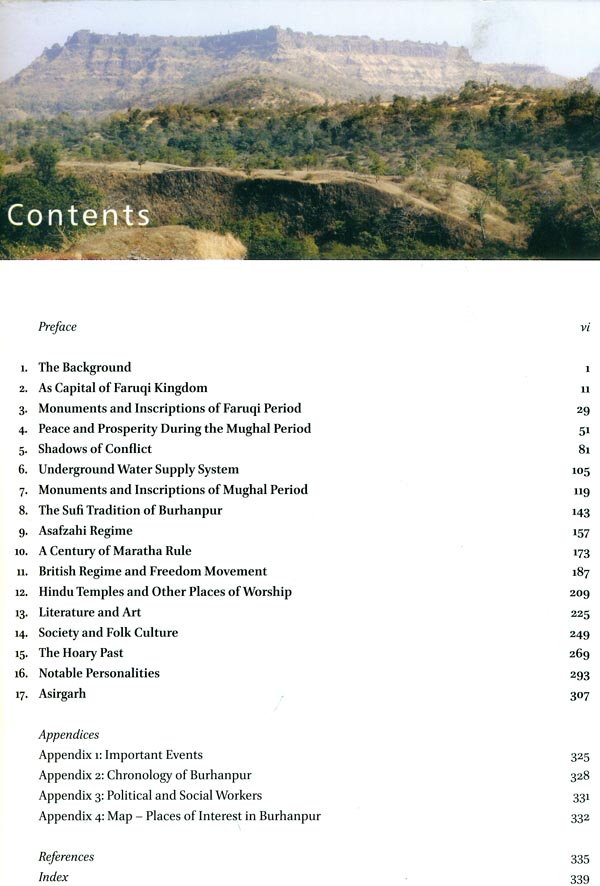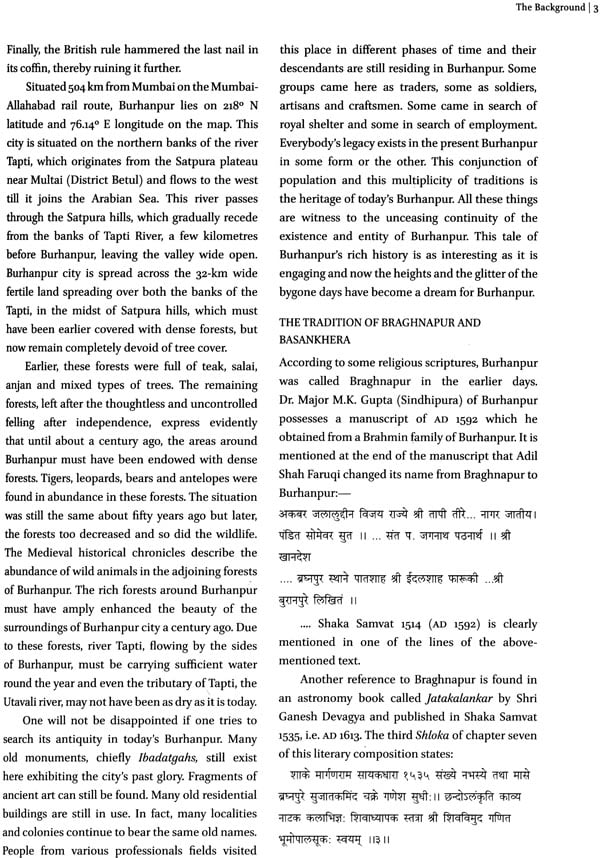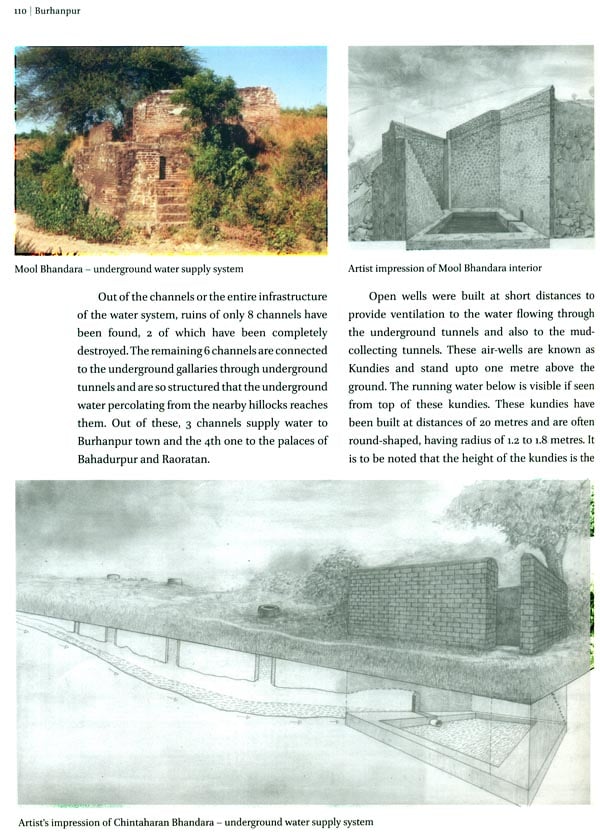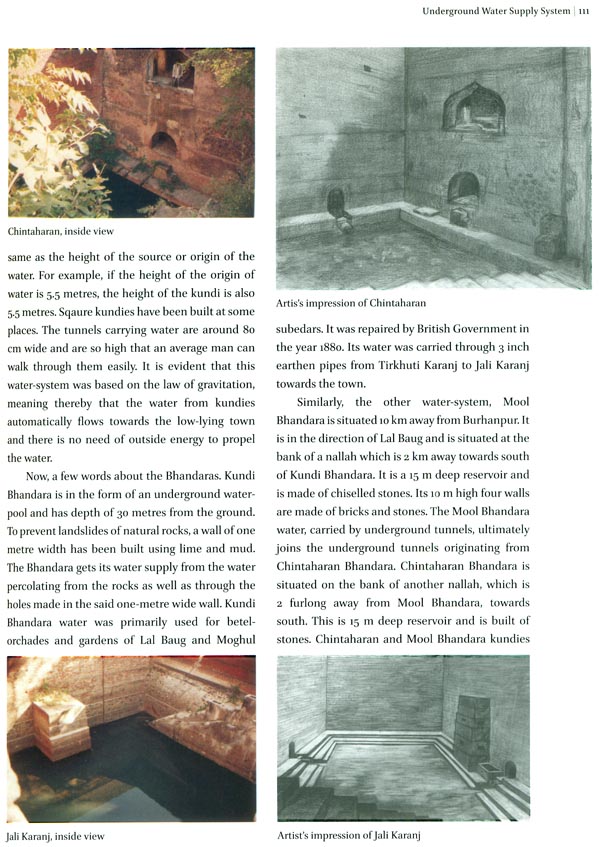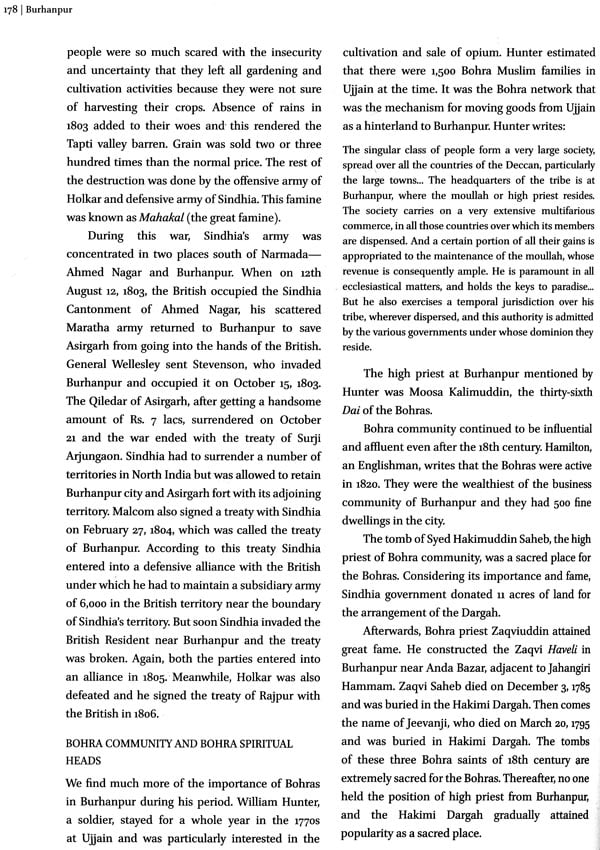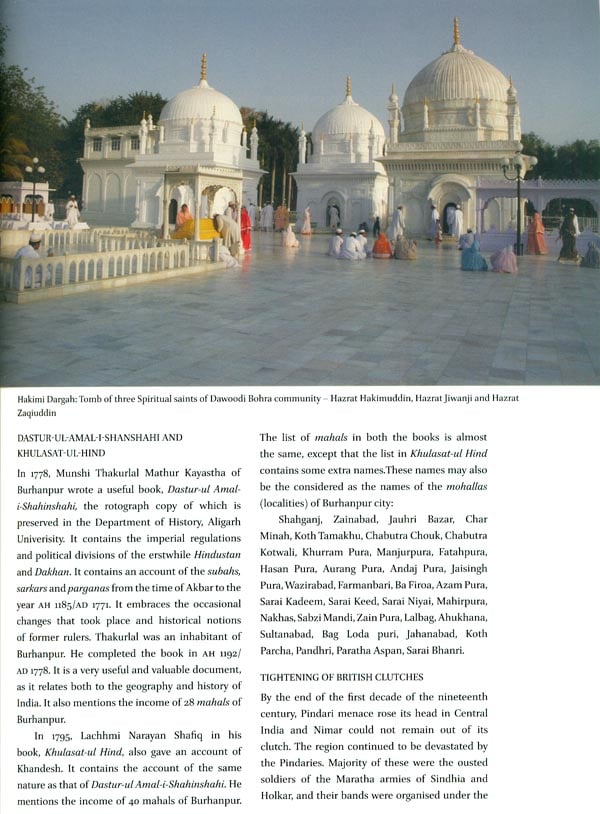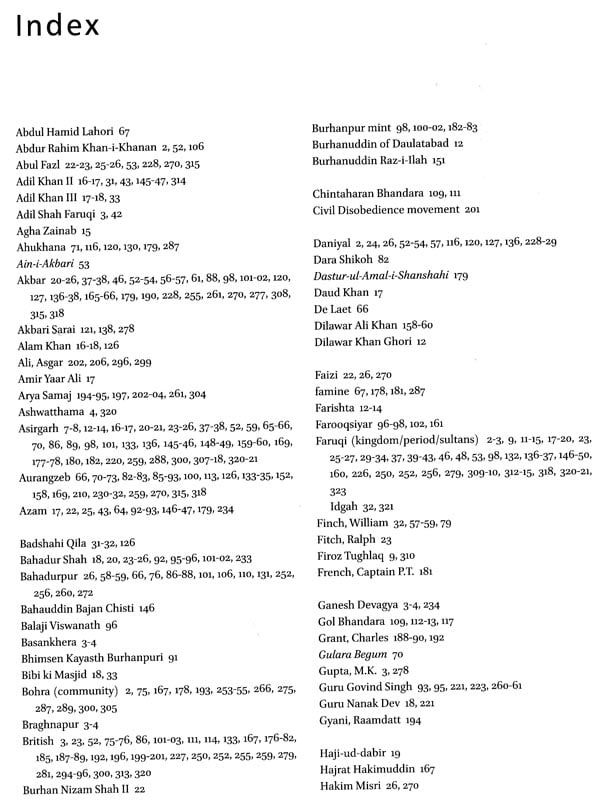
Burhanpur - Unexplored History, Monuments and society
Book Specification
| Item Code: | NAP985 |
| Author: | Suresh Mishra & Nandkishore Dewda |
| Publisher: | ABI Prints and Publishing Co. |
| Language: | English |
| Edition: | 2018 |
| ISBN: | 9788186787212 |
| Pages: | 349 (24 B/W & throughout Color Illustrations) |
| Cover: | HARDCOVER |
| Other Details | 12.00 X 8.50 inch |
| Weight | 2 kg |
Book Description
The present volume deals with the history, culture and social life of Burhanpur since its inception. Founded by Faruqi ruler Nasir Khan in 1407, the city was the capital of the Faruqi kingdom for two centuries, till its occupation by the Mughal emperor Akbar at the close of the 16th century. The Faruqi rulers were quite tolerant by the standards of those times and consequently Burhanpur gradually became a centre of the Su? saints who came and settled here from all parts of the country. Raja Ali Khan, a Faruqi Sultan was so liberal that he inscribed Sanskrit inscriptions along with the Arabic inscriptions in the mosques of Burhanpur and nearby Asirgarh. After the fall of the Faruqis, the Mughals held their sway, and Burhanpur became the headquarters of the Suba of Khandesh becoming very important politically. During the Mughal rule, peace and prosperity prevailed, leading to an increase in trade and commerce and the city became an important centre for domestic and foreign trade. Gujarati and Rajasthani traders and Bohra community capitalized on this trade opportunities and settled here.
For the huge population of Burhanpur, a unique water supply system was built during the reign of the Mughal Emperor Jahangir on the lines of Qanat system of Iran, under the supervision of Abdur Rahim Khan-i-Khanan, who stayed at Burhanpur for many years as an administrator.
During the later Mughals, due to Maratha onslaughts, the trade and commerce of Burhanpur was affected adversely. The Nizam tried to give some stability by building a long rampart wall around the city to protect it from Maratha onslaughts, but ultimately he had to succumb to the growing Maratha power and Burhanpur was occupied by the Peshwa in 1750. Later Peshwa handed it over to the Scindia in 1778 who held it till 1860.
There has ?been a confluence of various religions in Burhanpur and people of various sects settled here, contributing to the growth of a composite culture. A couple of chapters in the volume are based on the memoirs of the older generation of the city, giving an intimate glimpse of the past.
Suresh Mishra
Born in 1937 at Maharajpur, Mandla MP, Dr. Suresh Mishra did his Ph.D. in History from Sagar University, M.P. He taught History in Government PG colleges of M.P. (1960 to 1997). Recipient of 'Dr. Shankardayal Sharma Srijan Samman (2012)' for high quality writings in History, he was awarded Senior Research Fellowship of ICHR (2009-2011), Swaraj Fellowship (2007-08) of Swaraj Sansthan, Dept. of Culture, Govt. of MP, Bhopal and All India Makhanlal Chaturvedi Award of Madhya Pradesh Sahitya Academy, Bhopal for his collection of Hindi essays. Dr. Mishra has authored 29 books on History and has published more than 150 popular articles on culture, wild life, environment, folk culture, development etc. He is also the editor of research journal Sandhan (Jhansi). Presently he is engaged in historical research and writing.
Nandkishore Devda
Mr. Nandkishore Devda is an entrepreneur, socialist, philanthropist and active figure in public life since 60 years. He is an avid traveller having explored all of India and most of Europe, USA and Canada. Born in 1928, at Burhanpur, Mr. Devda is a firm believer of Dr. Ram Manohar Lohia's socialist philosophy. He actively participated in the Grain movement and student movement of 1942. He was arrested under MISA in 1976.
He is the founder of the renowned 'Milan Mithai' (since 1954). President of famous 'Navratri Vyakhyamala' (1963 to 2000), he has also been the convener of 'Gunjan' cultural organization and Federation of Film Club (1967-1982).
Mr. Devda has published 300 lectures delivered under the auspicious of Navratri Vyakhayanmala in 10 volumes of Chintan. He is the co-author of the book Burhanpur: The City of Hydraulic Wonders.
The Navratri Vyakhyanmala Samiti of Burhanpur city, to benefit the locals, tried continuously for thirty five years to create an atmosphere of learning by inviting learned and eminent personalities from across the country. Keeping their endeavour in mind the Samiti aspired to produce an authentic illustrated book on the glorious history and culture of the city which would suffice the popular taste. At Samiti's behest we took up the responsibility of writing the book based on historical research supplemented and complemented by local inputs.
Writing a book on Burhanpur city was not only an academic exercise for both of us, but an emotional experience as well. While working on the history of Burhanpur, gradually many pages of the bygone days of the city unfolded and we had to scan the lanes of Burhanpur a number of times. By peeping into the past of the Dargahs, anonymous ruins, old families, ancient havelis and the places of worship of Burhanpur, we could also collect ample useful information not only about the history of Burhanpur but also of the social, economic and cultural life of the region. It was all like a living history to us, which was now gradually on the verge of extinction. We were overwhelmed by meeting all and sundry, and writing the book became a mission to us. Detailed discussions were held from time to time with Tejpal Bhatt and Vijay Dixit, both of Burhanpur, in order to bring out a book which could stand up to the expectations of Vyakhyanmala Samiti.
There is no authentic information about the existence of Burhanpur city prior to AD 1407 but in the following years, a lot was written about Burhanpur in the memoirs of foreign travellers, Persian chronicles of Faruqi and Mughal periods. History of Burhanpur during Maratha period is available in Marathi sources written in Modi script. As for the British period, there is no dearth of information. For material around the period of independence, recollections of elderly persons of the city were highly enriching.
For full two centuries, this city was the capital of the Faruqi kingdom when it witnessed many upheavals. During this long span of time, the city witnessed many wars and conspiracies- proving a hindrance to its progress. The kingdoms of Malwa, Gujarat, Bahamni and Berar surrounding Khandesh and its capital Burhanpur continuously created problems pushing them to consume their entire capacity in defending themselves, which in turn adversely effected the economic condition of the Faruqi Sultanate, Burhanpur being no exception.
The Faruqi rulers were quite tolerant from the standards of those times and consequently Burhanpur gradually became a centre of the Sufi saints who poured from north and south India during the entire Faruqi rule of two hundred years. Numerous tombs of Sufi saints, spread over this city are evidence to this fact. While, Hazrat Shah Bhikari was the most ancient and notable Sufi saint of Burhanpur, Shah Isa Jundullah, Shekh Ali Muttaqi and Hazrat Burhanuddin Raj-i-Ilah were not only saints but also renowned scholars of Persian and Arabic and wrote many books in these languages. Hazrat Bahauddin Bazan was a poet of Rekhta. Raja Ali Khan, the Faruqi Sultan was so liberal that when he built Jama mosques at Asirgarh and Burhanpur, he, along with the Arabic inscription, got inscribed a Sanskrit inscription. Hardly any mosque in the world may be having such a detailed Sanskrit inscription.
After the fall of the Faruqis, the Mughals held their sway, and Burhanpur became the capital of the Suba of Burhanpur and its political importance was retained. During the Mughal rule, peace and prosperity prevailed leading to an increase in trade and commerce with the city becoming an important trade centre. Surat port gaining importance in the western coast contributed a great deal towards the prosperity of Burhanpur. The trade route leading to Surat passed through Burhanpur making it the centre of both foreign and internal trade. Gujarati and Rajasthani traders and those of Bohra community of Burhanpur capitalized on this trade opportunity.
Another reason adding to importance of Burhanpur was development of huge cantonment, for the Mughal's army heading towards the Deccan. All these factors led to the increase of population of this city. For this huge population a unique water supply system was built during the reign of the Mughal Emperor Jahangir. Built on the lines of Qanat system of Iran, it was completed under the supervision of Abdur Rahim Khan- i-Khan an who stayed at Burhanpur for many years as administrator. Khan-i-Khanan was none other than the popular Hindi poet Rahim, whose couplets are widely recited by the common lot.
When power of the Mughals declined and the Marathas took over, Burhanpur had to bear the brunt of this change affecting the trade and commerce badly. During the later Mughals, Nizam in power tried to give some stability by constructing a long rampart around the city to protect it from Maratha onslaughts. But the Nizam had to finally succumb and Burhanpur came under the Peshwa in 1750 and continued till 1778. Commencement of Maratha rule gave impetus to growing Maratha culture in the city. In 1779 Peshwa handed over Burhanpur to the Sindhia, who held it till 1860. A century of Maratha rule contributed in making Burhanpur the centre of Maratha culture. The Hindu-Muslim composite culture developed during the three century Muslim rule was enriched with a third stream of Maratha culture of the Deccan. Rarely such coincidence is seen in any other city of India.
In different phases of history, Burhanpur became a centre of administration, military activities, trade and commerce. Traders from Gujarat and Rajasthan settled here. During the upheaval of 1857 uprising, numerous Muslim weavers migrated from north India to Burhanpur and in due course they were known as Hindustani Musalmans. All sorts of artisans flocked here from different quarters. Due to the influx of different linguistic and social groups, a kaleidoscopic society, enriched with cultural variation, blossomed here. There has been a confluence of various religions like Hinduism, Islam, jainism etc., in Burhanpur. People of various sects of different religions dwelled here helping in the growth of a composite culture. Urdu and Persian literature flourished with great gusto. Jama Masjid, its Sanskrit inscriptions, water supply system of Mughal times, Beed of Guru Granth Saheb with Guru Govind Singh's Signature, the namaaz of Bara Bafaat at Hazrat Bhikari Shah's Durgah, Balaji fair, Baragadi festival, Pol a festival and Rekla race centered on cattle, provide special flavour to the present city of Burhanpur.
Initially only six chapters were visualized for the proposed book, but as the work progressed, new information was collected, increasing the number of chapters to seventeen. Chapters 14, 15 and 16 are purely contribution of locals, with nostalgic narrations giving a fragrance of personal, emotional attachment with the city. These chapters form the memoirs of the older generation of Burhanpur, with the intention to bring forth to the present generation the Burhanpur of their times, capturing a throbbing pulsation and life, which can inspire even today.
Our work will reach its logical consequence, if this book inspires the citizens of Burhanpur to conserve the heritage of the glorious and prestigious past, which is alive in the form of buildings, traditions, refinements and social relationships.
By completing this book, we feel to have fulfilled a responsibility bestowed upon us. We heartily express our gratitude to the advisor Pt. Tejpal Bhatt and Prof. Vijay Kumar Dixit and Dr. Major M.K. Gupta who gave us information regarding the historical, archaeological and numismatic heritage of Burhanpur and Dr. N.M. Kansal of Gwalior, who gave us details of Sindhia coins. We are grateful to Shri Omkar Kadu and friends, who prepared sketches of historical monuments and Shri Rajesh Pullarwar, who prepared the layout and design of this book making it more impressive. Other information was obtained from Hajrat Ikramullah Bukhari. The photographs of this book have been prepared by N.A. Saiyed, Retd. Chief Photographer, Archaeological Survey of India (ASI), Vadodra, Shailendra Kumar, Sr. Photographer, IGIMS, Patna, Hemat Arya and Nayan Kapadia. We also express our gratitude to Prof. B.K. Shroff for English and Dr. Shri Ram Parihar for Hindi drafting work of this book and to Mohit Kumar Chaukiker and Haresh Saraf for DTP work. We also thank the members ofVyakhanmala Samiti for assisting in collecting the matter for the book from time to time. We are also indebted to all those people of Burhanpur who provided invaluable information about the city.
**Book's Contents and Sample Pages**
